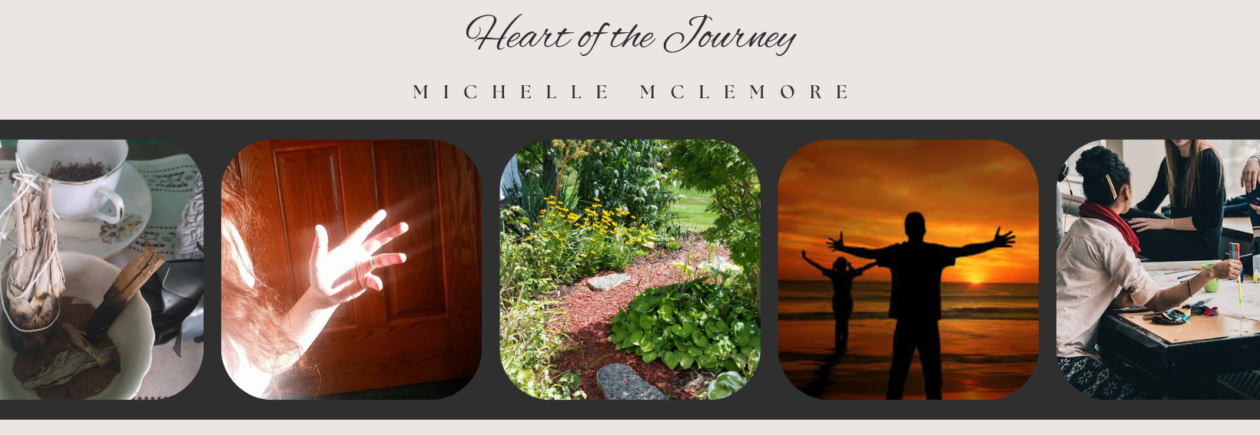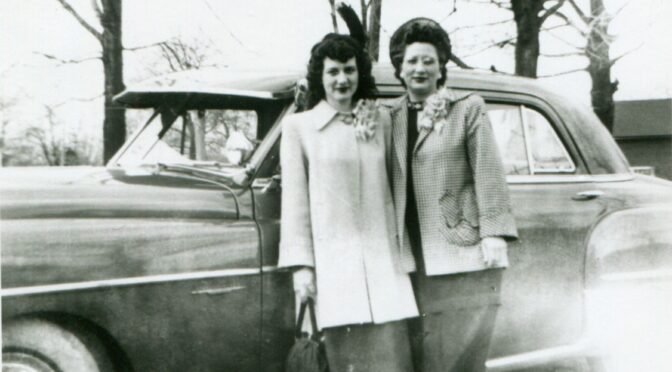By Michelle McLemore
This article was first published in Crazy Wisdom Community Journal September 1, 2023.
Have you ever gone down a rabbit hole? (Figuratively, of course.) Warrens can be exciting–as well confusing. Some leads are dead ends while other passages lead you quite a way from your starting point—almost to the extent that you forget what you were originally searching for.
My sister Lisa and I often joke about our rabbit hole research inquiries. The thrill of the potential finds keeps us searching. What started as separate hobbies eventually merged to combine into writing local history as well as GENMEMS (genealogical memoirs and house histories) for clients. Lisa summed up her genealogy enthusiasm by saying, “It’s like a puzzle, or mystery, to see how everything connects or impacts each other.” That connectivity is what we all need to take a closer look at to understand our inherited (yet transformable) tendencies, how we can gather strength from our ancestors’ stories, and finally, how to keep descendants and future communities in our conscious decision-making.
Let’s start with basic biology. I, for example, was born July 15, 1972 to Loretta Mae (Rang) Coberley. Yet, the story of influences upon me from a biological layer began earlier—and the same is true of you. The egg that would become me, grew within Loretta in her first four months of gestation within her mother, Virginia Ann Estella (Cote) Rang approximately between December and March 1933—early in the Great Depression. (In short, Grandmothers grow their children’s and their grandchildren’s eggs simultaneously.)
We could start here and look for stressors on Virginia, or we could go back another couple generations to see what type of genetic patterns may have been passed to Virginia (as an egg) from her ancestors.
Virginia’s egg was developed during the Great Blizzard of 1888, post Civil War tension, temperance, and other reform furies. Her great-grandmother started as an egg toward the end of 1853 as westward expansion continued and eking life out of the rural landscape of Ohio was the daily grind.
Why does gestational egg development matter? Research has established that psychological stress immediately preceding conception and during the initial stages of pregnancy can impact the growing child with preterm births, early deaths, mental complications, and can cause compounding problems in four successive generations. That’s right, the next four generations.
Studies from 1999 to 2017 show strong evidence that psychological stress on a pregnant mother (such as depression or intimate partner violence (IPV)) caused a variety of additional effects such as increased risk for attention deficit hyperactivity disorder, autism spectrum disorder, schizophrenia, major depression, and anxiety-related disorders in increasing complexity with each next generation.
Simplified, the mental, emotional, spiritual, and physical stress of your grandmother and mother may have programmed you to be inclined to anxiousness or depression; it may have rewired your immune system and brain to react in certain less-than-healthy ways.
So, let’s take a closer look at my family models. For the sake of space, we’ll explore just two generations, though our research revealed at least four generations of economic challenges.
Grandma Virginia was conceived in 1914 in times of hardship, the third of nine children. Virginia’s family experienced poverty, scarcity, and uncertainty before it became fashionable in the Great Depression.
Whooping cough, Scarlet Fever, and Dyptheria worked through the entire family in 1919. December gifted the measles for Christmas. Virginia’s father fell off a garage in 1924, landing on his head. Then in November fell and was laid up for two years with internal injuries. Foreclosure was a continuous mid 20s concern. In 1927 a house fire destroyed the clothes room and all of Virginia’s clothes. By 1930 they lost their home and moved into a shack. They wore castoff clothes, shoes, and picked up coal along the railroad that had fallen off the railcars . All the children dropped out of school as soon as they could hold jobs. A nephew recounted that when they came to visit, the children would even eat the bones because they were so famished. The constant instability no doubt left lasting impressions on Virginia. Yet, frugality, determination, and faith—lifelong lasting values—saw her through.
In 1932 at age 18, Virginia married Earl Rang. The Great Depression was in full swing when they conceived my mother, Loretta in ‘33. The feelings of scarcity again left their mark on this first child. Later in life, Loretta would occasionally let slip kernels of wisdom to us such as, “When you squeeze your ear, you forget you are hungry… for a little while.”
In 1938 Virginia’s sister Rita and husband Clarence were laid off and living in a tent in Virginia and Earl’s back yard for the summer. To support themselves the aunt and uncle worked in farm fields picking and pitting cherries and gathering potatoes at a neighboring farm. They earned three cents a bushel while Virginia’s brother Charlie earned 15 cents per hour to load baskets into the truck. Each family member helped out the best they could.
In 1941, Virginia joined Willy’s-Overland Women’s Motor Defense Corps. This club trained women for duties with the Army. They learned skills such as first aid, nutrition, and driving motor vehicles. As part of this, Virginia and her sister Rita received firearms and training by the Toledo Police Department. They also completed classes on the principles of automobile construction, maintenance, and operation to be qualified as proficient motor vehicle technicians. Virginia even went on to teach a class on carburetor repair. She did not let her female status limit her ability to serve or prepare to help her nation in times of need.
Draft letters to married men went out in 1943 and husband Earl joined, training in California. Yet, by the next summer, Virginia was in the hospital and Loretta age ten and her two younger brothers, Charles and Richard, were forced to go live with another family. Earl received an honorary discharge in 1944 so he could return and take care of the family. No doubt there was rejoicing when the family was reunited. Still, what kind of uncertainty and anxiety had worked into the children’s psyche about abandonment or fear of being orphaned by one or both parents? Mom never spoke of this separation.
Loretta attended school, doing fine but frequently felt “ill” during Latin class and had to report to the nurse’s ward, befriending the nurse and caring for others. She would find solace from the no-nonsense parenting of her mother by helping at the horse farm where her horse was boarded.
Things began looking up. Loretta married local boy LeRoy Coberley in 1952 at age 18 and by 1956 they purchased a farm in Michigan. Then, Loretta’s father Earl died of a sudden heart attack. A year later, her brother Charlie died in a head-on collision with a semi returning from a visit at the Michigan farm. Loretta was heart-broken and had PTSD-type reactions driving past where the accident occurred for many years.
Virginia went to work building an impressive Stanley Home Products marketing and distribution group supplying the remaining two children, and herself, with the basics they needed. She refused to play the victim or depend on the government. She was always dressed to sell, having learned the hard way that one’s appearance will sway how others view you. Even in the last few months of her cancer battle, Virginia wanted her nails painted. My mom grimaced uncomfortably when one of the brothers tossed a ball cap on Virginia’s head in attempts to be funny in her last days. A ball cap was never part of Virginia’s style.
We could wonder if Loretta’s migraines, scratching anxiety habits, and fibromyalgia were ingrained by the stress during gestation or the strain of life. However, attitude-wise, Loretta inherited the will and grit to endure and keep going—a balance no doubt demonstrated by observing her extended family.
My mother, Loretta, bless her, was definitely a child of the Great Depression, her mother’s expectations, and the yearning of someone with big ideas but little self-confidence.
Loretta was a thing-saver—because you never knew when something could be re-used, upcycled, or gifted. She taught us early that “good clothes” were for going out in and immediately upon our return home, “home clothes” were to be put on in order to make the good clothes last as long as possible. Home-sewn and second hand were normal. Loretta made the bridesmaid dresses for all of her daughter’s weddings in addition to prom dresses and costumes. She saved what money she could get from her own Stanley Home Products sales or what Dad gave her as an occasional allowance or groceries. She knew banks could fail. And yes, when she passed, we had to go through every book, stack of linens, cannisters, and the like because she had hidden away her own stock and store for emergencies.
From the lean years, Loretta learned charity, kindness, and community service was important. She helped at school and served others through church and 4-H. She even gained enough signatures to make an intersection near her home a four-way stop for safety. She participated in every election even though she joked she probably cancelled out Dad’s vote.
As a stress management coach, teaching my clients that generational stress patterns are real helps them to feel less “crazy.” Examining ancestral stressors can help us understand systems built on fear, anger, victimhood, or the healthier patterns of resilience and determination. The research shows that not every child born during extreme stress develops stress-induced negative behaviors. This speaks to the power of the ancestors’ grit and resilience—how they evaluated challenges and worked to create manageable living expectations…and modeled those proactive strategies for their children. The genes may be there, but the family witnessed positivity and therefore character strength prevailed.
The Seventh Generation Principle is a philosophy across many different indigenous groups. The ancient Haudenosaunne (Iroquois) speak of it as responsible living. To practice it requires making decisions with forethought so that each decision will lead to a sustainable world for the next seven generations. In thinking this way, what to buy, sell, build, plant, create, recycle, trash, or destroy all carries a much heavier responsibility and diminishes the potential for rashness, selfishness, and hedonistic tendencies.
History is a teacher with both scars and gifts, if we will listen to it. We should add to it as new facts surface, and keep in mind enlightenment is a constantly evolving state of existence.
To learn and remember what one’s ancestors endured, struggled through, fought against, and rose above, can offer a fountain of grit, endurance, and hope. We can identify problems yet refuse to cave to disillusionment. We can give grace to ancestors as we learn why they came to be the people they did. Talk to the family member, or neighbor, you disagree with. Better yet, listen. Find the commonality you both share. It exists. Build on it for your health, your families, your community, and your world. Then, share your story. The history you make today is just as vital as the history which came before.

